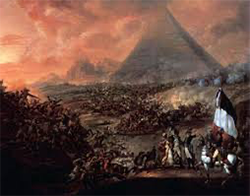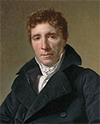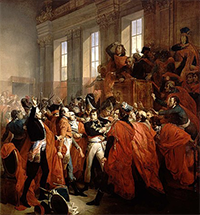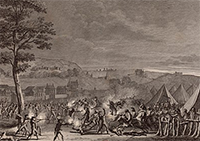The French Revolution
Part 9: New Authority Figures
The war continued, with France fighting against Austria and Great Britain. The Director in charge of military affairs, Lazare Carnot, oversaw a three-pronged attack against Austria. The forces under two generals, Jean-Baptiste Jourdan and Jean Victor Moreau, marched against Austria forces in the north but met with defeat. The Army of Italy, under Bonaparte, had sustained success. The Directory also convinced Spain to come into the war as an ally of France, opposing Great Britain. The Directory engineered another governmental overthrow in September 1797, in order to counter a resurgence of royalist strength. The elections of that year had delivered 87 more royalists into the legislature than the year before, and republicans feared that the next election would result in even more. Among those that the coup plotters wanted to get rid of was Jean-Charles Pichegru, the President of the Council of Five Hundred. In what is known as the Coup of 18 Fructidor, Year V, a cadre of Directors joined with the military to declare martial law in Paris and then arrested Pichegru and other leading royalists, including two members of the Directory. In all, soldiers (including a contingent sent from the field by Bonaparte) arrested 214 deputies and sent many of those into exile. This coup stood until the next year's elections, in which radical elements made gains once again. 
After his success in Italy, Bonaparte found himself in demand elsewhere. Recalled to Paris, he began planning an invasion of Britain. That never materialized, mainly because he was of the firm opinion that such a plan could never work so long as British forces controlled the high seas. Instead, he led troops against British interests in the Middle East. Bonaparte and 35,000 soldiers, aboard 200 ships, sailed for Egypt. They captured Malta, then Alexandria, and then, on July 21, 1798, defeated the Mameluks in the Battle of the Pyramids. All of that seemed for naught on August 1, when the British fleet under Admiral Horatio Nelson savaged the French fleet at the Battle of the Nile. France had yet another enemy during the War of the First Coalition, the United States. The two countries had signed the Treaty of Alliance in 1778, bringing France into the American Revolutionary War on the side of the U.S. and against Britain. Now that France was again fighting Britain, France expected the U.S. to honor its commitments under the Treaty of Alliance. The U.S. instead ratified an agreement with Britain, the Jay Treaty, in 1795, and France began to seize American merchant ships. An attempt at negotiation resulted in the XYZ Affair, whereby three American agents were humiliated by the French foreign minister, Talleyrand, who demanded bribes before even starting negotiations. President John Adams authorized funds to bulk up the American Navy, but the two countries never officially went to war. In 1799, France found itself again at war on multiple fronts, against multiple enemies. Back in the fray was Prussia. New to the conflict was Russia. This new alliance formed the basis of the War of the Second Coalition. The allies enjoyed some initial victories, but France again scored decisive victories, sending its enemies retreating, in one case over the Alps. The elections for the Directory and the two legislatives Councils took place in March and April 1799. The result was a period of political chaos, as royalists and republicans jostled for supremacy amidst the backdrop of war. A group of Jacobins opened a new political club called the Club du Manege, along the lines of the clubs that were popular in the early days of the Jacobin Clubs. The Councils called for a forced loan of a large sum of money, in order to finance the ongoing war effort and to keep the government finances afloat; as well, the Councils called for a new round of conscription, the first since 1793. A great uncertainty accompanied a growing instability, and many French people longed for the days when they could predict what was going to happen from day to day. Operating amid uncertainty was the Directory as well. Suspicious of the possible radical intentions of the Club du Manege, the Directory ordered it closed, in August 1799. 
The end of the Directory came in 1799, as the result of the Coup of 18 Brumaire. Emmanuel-Joseph Sieyès (right), a leader of the Revolution from as far back as the late 1780s, won election to the Directory. He then overthrew the government, although things didn't go exactly as planned. The plan was to initiate a takeover by devious means, by inventing a conspiracy and then tricking the government into handing over the reins in time of crisis. Helping execute the plan were to be Joseph Fouché, the Minister of Police; Pierre François Réal, the Commissioner of the Directory; Charles-Maurice de Talleyrand; and Lucien Bonaparte, who was a brother of Napoleon and who was also the head of the Council of Five Hundred. The plan was for three of the five Directors to suddenly resign, leaving the government with no functioning executive arm. Then, the Councils would hear of an alleged conspiracy that necessitated the movement of the deputies to a safe location a few miles outside Paris. Because it would be a time of war, since the republic was threatened from within, the Councils would be dissolved and a handful of its deputies would set about writing a new Constitution. This was a pattern that had been followed in recent years. The coup plotters brought the army in on the deal, and Fouché was to ensure that the police did their part. Also playing a part would be Napoleon himself, by this time a war hero with several well-known victories under his belt. 
On November 9, deputies in the Council of Ancients heard of the alleged conspiracy at an emergency meeting, at which they agreed to meet the following day at the Château de Saint-Cloud. They also assented to allowing Napoleon to assume command of troops in Paris. A few hours later, the same set of events occurred at a meeting of the Council of Five Hundred, with the same result. Troops then arrested two prominent Jacobin directors, in keeping with the story that it was a Jacobin plot to take over the government. The following day, the Councils met separately, with Napoleon speaking to each group. The Council of Ancients offered no opposition. The Council of Five Hundred did, but only for a time, in the form of harsh verbal resistance from a handful of Jacobin deputies. In the end, after soldiers had intervened and First page > Medieval Orgins > Page 1, 2, 3, 4, 5, 6, 7, 8, 9 |
|
Social Studies for Kids
copyright 2002–2026
David White



 In April 1796, a number of Jacobins led by Françcois "Gracchus" Babeuf, a publisher and former priest turned agitator, put in motion plans to overthrow the new government and restore the government mandated by the previous blueprint, the
In April 1796, a number of Jacobins led by Françcois "Gracchus" Babeuf, a publisher and former priest turned agitator, put in motion plans to overthrow the new government and restore the government mandated by the previous blueprint, the  removed the agitators, the lower chamber reconvened and approved the formation of a new government, by way of the
removed the agitators, the lower chamber reconvened and approved the formation of a new government, by way of the 
